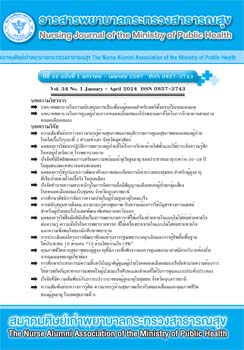Factors Predicting Awareness of Warning Signs Management among Risk Group Stroke Patients in Community, Ubon Ratchathani Province
Main Article Content
Abstract
Patients at risk of stroke have a chance to face with critical conditions due to cerebrovascular accident any time. Thus, they should be aware of warning signs in order to promptly manage their risks of stroke. This study used a predictive correlation research design conducted to examine awareness of stroke warning signs management and its predictive factors among patients at risk of stroke in community. The participants included 160 patients at risk of stroke in Ubon Ratchathani Province. Data were collected by questionnaires to assess personal information; perceived leading factors, enabling factors, and contributing factors for stroke; and awareness of managing the warning signs of stroke. These questionnaires were reviewed for content validity by experts. The CVI values were .86, .94, .75 and 1.0, respectively, and their reliability values were .77, .88, .75, and .76, respectively. Data were analyzed by descriptive statistics and stepwise multiple regression analysis. The results showed that awareness of stroke warning sings management among patients in the community was at a high level, which perceived risks for stroke and the contributing factor related to support from health personnel were significant predictors for awareness of stroke warning sings management among patients at risk of stroke in the community. These factors could explain 25.00% of the variances of awareness of stroke warning sings management (R2=.25, p<.05). The findings in this study indicate that health care providers should encourage the patients to be aware of the risks of stroke and promote awareness of prompt management when warning signs occurre to reduce mortality and disability in stroke patients.
Article Details

This work is licensed under a Creative Commons Attribution-NonCommercial-NoDerivatives 4.0 International License.
บทความและรายงานวิจัยในวารสารพยาบาลกระทรวงสาธารณสุข เป็นความคิดเห็นของ ผู้เขียน มิใช่ของคณะผู้จัดทำ และมิใช่ความรับผิดชอบของสมาคมศิษย์เก่าพยาบาลกระทรวงสาธารณสุข ซึ่งสามารถนำไปอ้างอิงได้
References
World Health Organization. World Stroke Day 2022 [Internet[. 2022 [cited 2022 Dec30] Available from https://www.who.int/srilanka/news/detail/29-10-2022-world-stroke-day-2022.
National Institute for Emergency Medicine. Situations and trends in health and emergency medicine (global and Thailand) [Internet].2022 [cited 2022 Nov 19] Available from http://www.niems.go.th/ 1/UploadAttachFile/2022/Ebook/414764_20220208161448.pdf.
Pesungnoen A, Suwonroop N, Pinyopasakul W. Factors predicting stroke prevention behaviors in patients at risk in primary care units. The Journal of Baromarajonani College of Nursing, Nakhonratchasima. 2018;24(1):41-56.(in Thai)
Wongsa D, Soivong P, Chaiard J. Quality of among stroke persons within six months post diagnosis. Nursing Journal. 2018;45(2):40-50.(in Thai)
Doungthipsirikul S, Wachiradilok P, Sirisamud T. The study of the emergency medical service situation and the development of emergency operation quality in stroke patients Report. National Institute for Emergency Medicine.2022.(in Thai)
Khantichitr P, Sanchaisuriya P, Thepphawan P. Time-to-treatment of stroke patients: experience from Ubon Ratchathani Province. Thailand. Journal of Health Systems Research 2016;10(3):277–88. (in Thai)
Suriya M, Siriruay M, Lekphet J, Soisungnoen T, Deeraksa S. Time to access and referral of stroke patients in Thakhuntho Hospital Thakhuntho District, Kalasin Province. Mahasarakham Hospital Journal 2020;17(3):140–7.(in Thai)
Pancioli AM, Broderick J, Kothari R, et.al. Public perception of stroke warning signs and knowledge of potential risk factors. JAMA 1998;279(16):1288–92.
Breckler SW. Attitude structure and function. Hilladate NJ: L.Erlbaum Association. 1986.
Wanna A, Kimsungnoen N, Namjuntra R. Perceptions and management of warning signs among persons at risk of stroke. APHEIT Journal of Nursing and Health 2020;2(1):30-44.(in Thai)
Korjedee P, Kittiboonthawal P, Namdej N, Chunchum J. A Predictive factors of the knowledge levels with stroke risk factors and warning signs in Saraburi community people. Nursing Journal of the Ministry of Public Health 2022;32(2):65-77.(in Thai)
Tanan R, Kompayak J, Srikhaw O. Awareness of stroke warning signs management among patients with high-risk hypertension. HCU Journal and Health Science 2018;22(43-44):13-26.(in Thai)
Sonti A, Noppakhun T, Duangchan C. factors influencing early hospital arrival among acute ischemic stroke patients in Hua Hin Hospital. Journal of Prachomklao College of Nursing, Phetchaburi Province 2022;5(3):24-38.(in Thai)
Kunlana K, Srisanpang P, Panpanit L, Tiamkao S. Factors related to treatment of stroke in patients with acute ischemic stroke in a tertiary hospital, Ubon Ratchathani Province. North-Eastern Thai Journal of Neuroscience 2021;13(1):31-43.(in Thai)
Kamsareeruk J, Jitpanya C. Factors related to prehospital time in patients with acute ischemic stroke 2015;7(2):106-19.(in Thai)
Ua-Kit N, Pensri L. Utilization of the PRECEDE MODEL in health promotion. Thai Red Cross Nursing Journal 2019;12(1):38-48.(in Thai)
VanVoorhis CW, MorganBL. Understanding power and rules of thumb for determining sample size. Tutorials in Quantitative Method for Psychology. 2007;3(2):43-50.
Best, J. Research in education. New jersey:Prentice-Hall.1981.
Rosenstock IM, Stretcher VL, Becker MH. Social learning theory and the health belief model. Health Education Quarterly 1998;15(2):175-183.
Komton V. Stroke patients’s self-management: application of empirical evidence. Journal of Thailand Nursing and Midwifery Council 2019;34(1):25-41.(in Thai)

